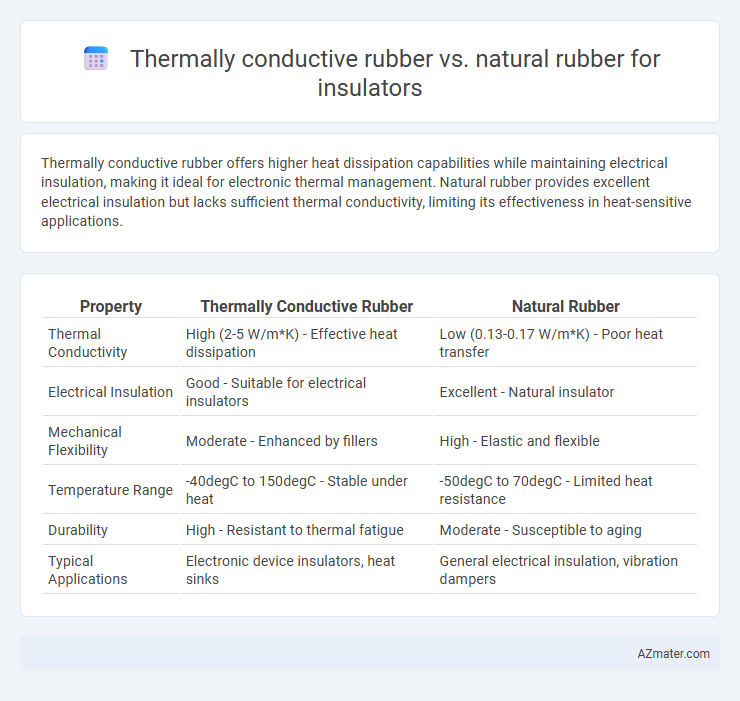Thermally conductive rubber offers higher heat dissipation capabilities while maintaining electrical insulation, making it ideal for electronic thermal management. Natural rubber provides excellent electrical insulation but lacks sufficient thermal conductivity, limiting its effectiveness in heat-sensitive applications.
Table of Comparison
| Property | Thermally Conductive Rubber | Natural Rubber |
|---|---|---|
| Thermal Conductivity | High (2-5 W/m*K) - Effective heat dissipation | Low (0.13-0.17 W/m*K) - Poor heat transfer |
| Electrical Insulation | Good - Suitable for electrical insulators | Excellent - Natural insulator |
| Mechanical Flexibility | Moderate - Enhanced by fillers | High - Elastic and flexible |
| Temperature Range | -40degC to 150degC - Stable under heat | -50degC to 70degC - Limited heat resistance |
| Durability | High - Resistant to thermal fatigue | Moderate - Susceptible to aging |
| Typical Applications | Electronic device insulators, heat sinks | General electrical insulation, vibration dampers |
Introduction to Thermally Conductive Rubber and Natural Rubber
Thermally conductive rubber offers enhanced heat dissipation properties due to the incorporation of thermally conductive fillers, making it suitable for applications requiring efficient thermal management and electrical insulation. Natural rubber, derived from latex of rubber trees, provides excellent elasticity, electrical insulation, and chemical resistance but has limited thermal conductivity, making it less effective for heat dissipation. The key distinction lies in thermally conductive rubber's ability to combine flexibility with significant thermal conductivity, whereas natural rubber primarily excels in mechanical resilience and electrical insulation.
Chemical Composition and Structure Comparison
Thermally conductive rubber typically contains fillers such as boron nitride, aluminum oxide, or silicon carbide integrated into a silicone or ethylene propylene diene monomer (EPDM) matrix, enhancing heat dissipation while maintaining electrical insulation. Natural rubber consists primarily of polyisoprene, a hydrocarbon polymer with a cis-1,4 configuration that provides elasticity but lacks intrinsic thermal conductivity. The addition of thermally conductive fillers in synthetic rubber alters its chemical composition and microstructure, creating continuous thermal conduction pathways, unlike the homogeneous, non-filled polymeric network of natural rubber.
Thermal Conductivity: Key Differences
Thermally conductive rubber exhibits significantly higher thermal conductivity, typically ranging from 1 to 7 W/m*K, compared to natural rubber, which generally has a thermal conductivity of around 0.13 to 0.18 W/m*K. This enhanced thermal conductivity in thermally conductive rubber results from the incorporation of fillers like graphite, boron nitride, or aluminum oxide, enabling efficient heat dissipation in electronic and industrial applications. Natural rubber's low thermal conductivity makes it suitable primarily for insulating purposes where heat transfer needs to be minimized.
Electrical Insulation Properties
Thermally conductive rubber offers superior electrical insulation properties combined with effective heat dissipation, making it ideal for electronic applications requiring both insulation and thermal management. Natural rubber provides excellent electrical insulation due to its high dielectric strength and low electrical conductivity but lacks significant thermal conductivity. In environments where preventing electrical current flow and managing heat are crucial, thermally conductive rubber surpasses natural rubber in performance.
Mechanical Strength and Durability
Thermally conductive rubber typically exhibits enhanced mechanical strength and durability compared to natural rubber, owing to its specialized filler materials that improve thermal conductivity and reinforce the polymer matrix. Its resistance to wear, deformation, and environmental factors such as heat and chemicals makes it ideal for demanding insulation applications. Natural rubber, while flexible and resilient, generally lacks the thermal performance and long-term stability required for high-stress insulator roles, limiting its durability under mechanical and thermal cycling conditions.
Temperature Resistance and Stability
Thermally conductive rubber exhibits superior temperature resistance, maintaining structural integrity and consistent thermal conductivity at temperatures up to 200degC, compared to natural rubber, which typically degrades above 80degC. The enhanced stability of thermally conductive rubber under thermal stress makes it ideal for high-temperature electrical insulation applications, ensuring reliable performance and longevity. Natural rubber, while flexible and cost-effective, lacks the thermal stability required for demanding environments, limiting its use as an insulator in advanced electronic and automotive industries.
Applications in Electrical Insulation
Thermally conductive rubber excels in electrical insulation applications requiring efficient heat dissipation, such as in power electronics, transformers, and circuit breakers, where managing thermal buildup is critical to performance and longevity. Natural rubber, while offering good electrical insulating properties and flexibility, lacks the thermal conductivity necessary for high-heat environments, limiting its use to low-temperature or general-purpose electrical insulation tasks. The enhanced thermal conductivity of specialized rubber compounds enables safer operation and improved reliability in advanced electrical insulation systems.
Cost and Manufacturing Considerations
Thermally conductive rubber offers enhanced heat dissipation properties but generally incurs higher material and manufacturing costs compared to natural rubber, which is widely valued for its cost-effectiveness and ease of processing. The manufacturing of thermally conductive rubber requires specialized fillers like boron nitride or aluminum oxide and precise mixing techniques to maintain thermal performance, increasing complexity and expense. In contrast, natural rubber benefits from well-established, economical production methods with minimal processing challenges, making it a preferred choice for cost-sensitive insulating applications.
Environmental Impact and Sustainability
Thermally conductive rubber offers enhanced heat dissipation with synthetic compounds that may involve higher energy consumption and limited biodegradability compared to natural rubber. Natural rubber, derived from renewable resources, supports biodegradability and has a lower carbon footprint, making it a more sustainable insulator option. Evaluating their environmental impact requires considering lifecycle emissions, resource renewability, and end-of-life disposal methods.
Choosing the Right Material for Insulator Applications
Thermally conductive rubber offers superior heat dissipation compared to natural rubber, making it ideal for electronic insulator applications requiring efficient thermal management. Natural rubber provides excellent electrical insulation and flexibility but lacks the thermal conductivity needed to prevent overheating in high-performance devices. Selecting thermally conductive rubber ensures optimal heat transfer and protection, while natural rubber suits applications prioritizing elasticity and basic insulation.

Infographic: Thermally conductive rubber vs Natural rubber for Insulator
 azmater.com
azmater.com